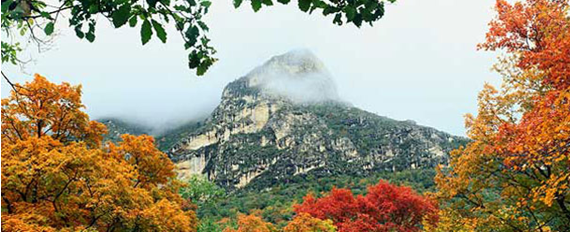
Isle Royale National Park
USINFO | 2013-08-21 16:57

Gateway City: Houghton Minnesota
Nearest Airport: Detroit Wayne County Airport (DTW)
Size: 571,790.11 acres
Date Founded: 1931
Annual Visitation: 16,000
Busiest Month: August (5,463)
Least-Crowded Month: December
Fees: 4
A densely forested, wind-lashed island wilderness in the northwest corner of Lake Superior, Isle Royale National Park offers outstanding backcountry recreation and rich human and natural history. It's one of the few places in the United States that's beyond the reach of the automobile—the only way to get into the park is via ferry or seaplane. And the island itself is a jigsaw puzzle of land and water, a complex topography that attracts kayakers, canoeists, divers, and anglers, as well as long-distance hikers.
A giant, jagged seam in the enormous crease left in the earth as glacial ice retreated some 10,000 years ago, Isle Royale is the largest island in the world's largest freshwater lake. Native Americans dug copper here 3,000 years ago. Later French, English, and Americans trapped a wealth of furs. During the 19th century's "copper fever," mining companies sank shafts in the bedrock and left behind are more than 1,000 mining pits. Commercial fishing supplanted mining in the early 20th century, until the park was established in the 1930s.
Isle Royale is ecologically complex. Three distinct forest types—including a remnant of ice-age boreal woodlands—grow on an island just nine miles wide and 45 miles long. A century ago, lynx and caribou were the dominant mammals. Today, these species are extinct, replaced by wolves and moose, which only arrived here from the mainland in the 20th century.
Backpack Greenstone Ridge Greenstone Ridge runs the island's length, and is named for the greenish, copper-laden basalt often visible in outcroppings. The 40-mile Greenstone Ridge Trail between Windigo and Rock Harbor runs along the spine of the island, from ferry to ferry. With detours to lakes, peaks, and abandoned mining camps, most hikers devote four or five days to make this outback journey. Camp along the way at the six designated sites, and at journey's end hop a ferry back to your starting point. The basalt flows along the trail are at times 800 feet thick—one of the earth's largest and thickest lava flows; the trail also passes glacial lakes, bogs, and swamps as well as up and over the summit of 1,394-foot Mount Desor, the highest point on the island.
Dive Superior's Wrecks Isle Royale's rocky shoals have long formed a hazard to passing boats. Ten major shipwrecks have occurred in park waters in the last 150 years and these sunken ships—preserved almost intact in the lake's cold waters—are now a mecca for sport divers. The America, a passenger steamer, sank in 1928 in fairly shallow water—the ship's keel rests 73 feet down but the bow is just a few yards below the surface. The ballroom, galley, kitchen, and engine room can be easily explored by divers of all levels of experience. The Emperor, a 525-foot bow-wheeler steamer, ran aground in 1947, and its stern rests in the deeps, 170 feet below. It is an awesome trip for an experienced diver, offering up views of steel beams and hull plates twisted like noodles, and a technically demanding penetration of the boat's huge engine room.
Howl with the Wolves Howl with the wolves, but it will inevitably be a lament for this beautiful creature. The island's eastern timber wolves are in trouble—their numbers are in serious decline after the pack was exposed to a deadly strain of canine parvovirus. Parvovirus attacks the intestines' ability to absorb water, causing the wolves to die of dehydration. For this reason, dogs and other pets are strictly forbidden (even aboard boats) near this rugged yet fragile island because of the devastating effects of introducing foreign diseases and viruses. The timber wolves play an integral role in controlling the island's moose population. Other wildlife on the island includes beaver, red fox, lynx, snowshoe hare, and mink. Check the skies for osprey and bald eagles.
Great Fishing, in Waters Big and Small Fishing the island's lakes and streams is relaxing and potentially rewarding: Fresh trout, walleye, and perch make a welcome and toothsome break from camp rations. No fishing license is required for the island's 20 inner lakes. One-day licenses are required for Lake Superior waters within the park's boundaries—lake trout and salmon are the fish of choice. The one-day license can be obtained at the Rock Harbor Lodge office.
Visit Isle Royale's Historic Lighthouses Isle Royale's historic lighthouses have served as pillars of light for over a century, helping ships and boats safely navigate the unpredictable swelling waters of Lake Superior. The Rock Lighthouse, built of stone and brick, was first lit in 1855. The red sandstone Isle Royale Lighthouse has served as a beacon since 1875. The Passage Island Lighthouse, built of fieldstone, has been guiding ships since 1882. The 117-foot Rock of Ages Lighthouse was completed in 1908.
Cruise the Waters of Island Royale The waterways around Island Royale provide boaters with an aquatic Atlantis of interconnected inlets, bays, coves, and the sheer majesty of Lake Superior. Dock space can be found at Daisy Farm, Chippewa Harbor, Malone Bay, McCargoe Cove, Passage Island, Hidden Lake, Edisen Fishery, and Raspberry Island. Even if you don't have a boat, there are ferries and water taxis that will allow you to explore some of the more remote waters around Island Royale.
Share this page



















